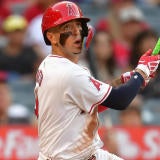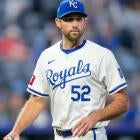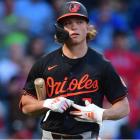We've heard ideas bandied about for how a 2020 season might get off the ground, but the latest proposal, as reported by Ken Rosenthal over the weekend, actually has some teeth to it. It's the one being passed between the owners and players — the starting point for what could lead to an honest-to-goodness start date — and, thus, is worthy of dissection for Fantasy Baseball.
My biggest takeaway is that some of the presumptions we were making — the ones that would most drastically impact a player's 2020 outlook — don't appear to be on the table anymore.
Here are my five other, more specific, takeaways:
1) The season would begin in early July
This had been the presumption for a while now, but it's the most important item of all, of course, and gives us a timetable for when things would need to happen. An agreement would have to be in place by the end of May, probably, to give players enough time to report for an abbreviated (likely three weeks) spring training.
It also gives you and your league-mates room to start talking about a potential draft date, be it it an initial one or a replacement one. I would say that a replacement one doesn't seem as necessary anymore, judging by what the proposal leaves out, but ultimately, it's for you guys to decide.
2) They're aiming for about 80 games now rather than 100
For weeks, we had been hearing 100, but still with that early July start date — which would have meant frequent doubleheaders, perhaps even weekly, and fewer off days. The schedule would have been "condensed," meaning players would have had less time to recover from one game to the next, which might have changed the way managers approached their pitching staff and starting lineup.
But 80 games from the start of July? That's ... totally normal. July 1 marks roughly the halfway point in a 162-game season, so the schedule wouldn't need to be the least bit condensed. It's still possible managers would go easier on their starting pitchers for the first couple turns, given that spring training would be shorter, but then they would have every incentive to let them pile up innings, with the usual time to rest in between, knowing that a low final tally might lower their limit for 2021 as well.
So all of the pitchers who we might have thought would have innings limits over a full season — guys like Jesus Luzardo, Julio Urias, Shohei Ohtani, Nate Pearson and Michael Kopech — should no longer have any such concerns. They wouldn't necessarily be asked to go seven innings every time since they're not already accustomed to doing that, but they wouldn't have their innings artificially suppressed either.
Off days for position players would presumably be handled as usual.
Of course, half a season's worth of games would mean half a season's worth of scoring periods, which might compel your league to reconsider the way your league's playoffs work. Chris Towers has some ideas along those lines.
3) Rosters would be expanded to as many as 45-50
Big number, huh? It's not a misprint, but it may be a misunderstanding.
I'm presuming Rosenthal meant that 40-man rosters would be expanded to 45-50. Active rosters would be larger than the standard 26, in all likelihood, but only a percentage of that 45-50. If owners are already concerned about having enough revenue to pay player salaries, they wouldn't propose a plan that would lead to so many more players earning major-league pay. Plus, it would create a service-time quagmire that isn't the least bit necessary with the schedule no longer shaping up to be a condensed one.
There's still the issue of top prospects needing to continue their development with the minor-league season all but certain to be canceled, but piling them onto double-wide big-league rosters isn't the way to do it. How much would they even get to contribute? And why would any organization want them accumulating service time if they're not contributing?
No, a taxi squad situation makes more sense. Each organization assembles a team of its best prospects, meaning the assets they don't want to lose important development time. The taxi squad travels with the big-league team, playing warm-up games against other taxi squads, and is there in an emergency if the active roster becomes depleted.
I'm largely speculating here — all Rosenthal's report offered was the 45-50 number — but Jon Heyman's Tweet Monday afternoon seemed to support my thinking:
MLB is suggesting rosters expand to 30 to account for a shorter spring and arms not as ready as usual, plus a taxi squad of perhaps up to 20 more to account for no minor leagues, which seems extremely likely.
— Jon Heyman (@JonHeyman) May 11, 2020
So 30 active roster spots — that's closer to what we were anticipating all along. It would give each team four extra spots to account for not having a full minor-league system at its disposal. And who would be filling those four extra spots? In same cases, prospects — the ones who are most clearly ready, anyway. I've already identified one such prospect for each of the 30 teams, which you can read about here. I suspect that most of the extra spots, though, would go to journeyman types who wouldn't need any sort of development time and would be more trusted to come through in a pinch.
Plus, if 40-man rosters are expanded by 10 for just the one year, then teams will need players that they're comfortable discarding once the year is over. Journeymen would fit the bill there.
4) Most, if not all, teams would play in their actual parks
This one comes as the biggest sigh of relief for me. For a while there, the proposals with the most traction were the ones that had regular season games being played at spring training venues — maybe just the ones in Arizona, maybe the ones in Florida and Arizona.
It made sense on a real-world level, allowing MLB to create sort of a biodome where nobody enters or exits. In theory, it would ensure the virus wouldn't interfere, but getting full buy-in from all involved parties was probably too big of an ask.
Whatever the reason, it appears to be off the table now, which means the circus environment of the Cactus League, where the ball behaves sort of like it does at Coors Field, is as well. Introducing half or all the league to that environment would have drastically changed the outlook for dozens of players, requiring a full-scale overhaul of the rankings and pretty much forcing any league that had already drafted to re-draft. Now, thankfully not.
Rosenthal did allow for the possibility that some teams might have to open at their spring training sites, but he singled out Toronto and the two New York teams, which all play their spring games in the Grapefruit League (i.e., a far less disruptive environment).
Of course, it would mean all of this research was for naught, but that's a tradeoff I can live with.
5) Teams would face only their division and the corresponding division from the opposite league
This one would introduce a new wrinkle that most of us probably hadn't considered yet. Limiting teams' opponents by geography was always on the table, but this specific form of it was not. It sounds like teams would play approximately twice as many games against their own division as against the opposing division, so it's important not to overestimate the impact. Still, there are effects to consider.
Every NL East team would play roughly one-third of its games against a stacked AL East and roughly one-sixth of its games in the hitter-friendly parks it has to offer. Well, four of the five are hitter-friendly, anyway, and I guess you could also argue Boston isn't. But still ... it's a tougher scenario for NL East pitchers than the one the NL West pitchers face by traveling to all those big parks in the AL West.
It would also mean teams face their in-division rivals even more than they're used to, which is great news for pitchers in the AL Central, with its two rebuilding clubs. Maybe someone like Jake Odorizzi becomes more interesting. Certainly Kenta Maeda and Lucas Giolito do.
I've already revealed my top five winners and losers, presuming this schedule shakeup comes to pass, so be sure to check them out. It's not a big enough change for me to overhaul my rankings, but a tweak here and there? Yeah, that makes sense.


















